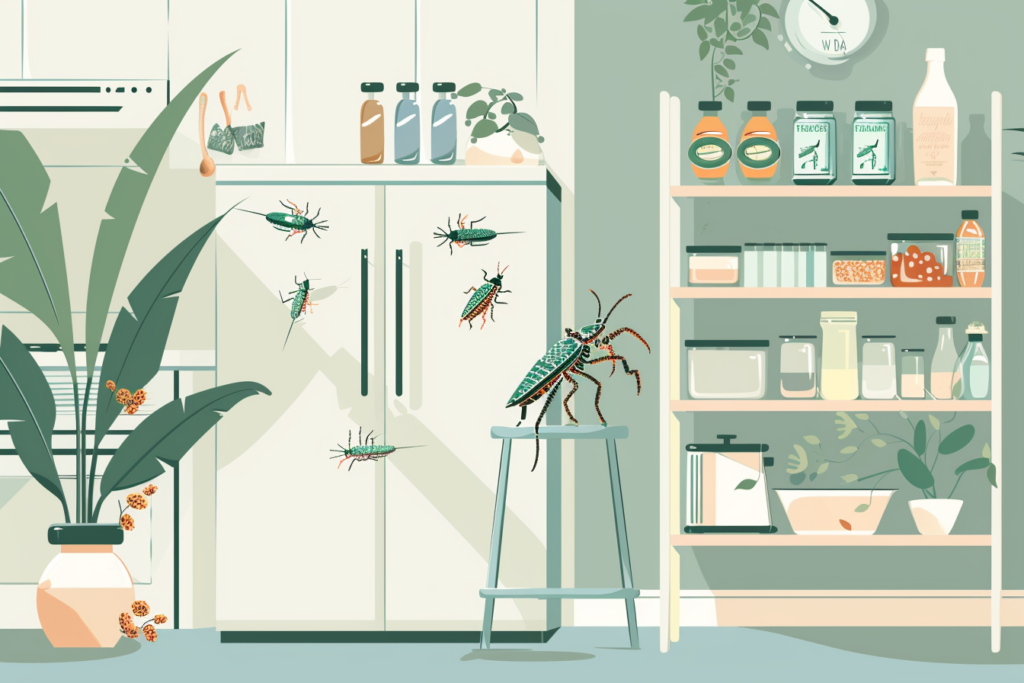A kitchen is a haven for creativity and nourishment but also a magnet for pests seeking food and shelter. Ants, weevils, moths, and rodents can quickly turn your cooking space into a nightmare if not managed properly.
However, with some practical tips and preventive measures, you can keep your pantry and kitchen bug-free. Here are nine tips for maintaining a clean and pest-resistant kitchen environment.
Understanding the Attraction: Why Pests Love Kitchens
Kitchens offer pests three things they are naturally drawn to food, water, and shelter. The abundance of crumbs, food packaging, spills, and moisture makes them ideal places for pests to thrive. Identifying what attracts pests is the first step in preventing an infestation, and then you can deal with keeping them at bay moving forward.
1. Store Food Properly
Storing food correctly is crucial for minimizing pest invasions. Here’s how:
- Airtight Containers: Transfer food items like flour, sugar, cereal, pasta, and grains into airtight containers. These containers prevent pests like ants, beetles, and moths from accessing food. They also keep food fresh much longer, which is a win-win.
- Sealed Packaging: If airtight containers aren’t available, use clips or secure packaging to seal opened bags and boxes.
- Label and Rotate Stock: Clearly label containers and rotate older stock to the front to use first. This prevents expired food from lingering.
- Refrigeration: Some perishable items, like flours and certain seeds, can be refrigerated or frozen to prolong their shelf life and prevent infestation. Make sure to read the back of the labels, because sometimes refrigeration can also dry foods out or make them soggy.
2. Clean Regularly and Thoroughly
A consistent cleaning routine discourages pests by removing their food sources and hiding spots. Wipe down countertops daily to remove crumbs and spills so no food lingers, especially before you go to bed. Use natural disinfectants like vinegar to sanitize surfaces.
Clean pantry shelves monthly, vacuuming or wiping them down with mild detergent. Move and clean behind appliances where crumbs accumulate. Clean out toaster crumb trays and stove burners regularly. Don’t forget about the drawer under the oven, which can be a big crumb culprit.
Finally, use garbage bags that fit properly and dispose of them frequently. Rinse cans with soapy water and dry thoroughly.
3. Seal Entry Points

Pests can squeeze through surprisingly small gaps, so sealing potential entry points is vital. Here are a few entry points to pay attention to and make sure are sealed:
- Walls and Floors: Inspect walls, baseboards, and floors for cracks or holes. Fill them with caulk or weatherstripping.
- Doors and Windows: Install weatherstripping or door sweeps on doors and windows. Repair any damaged window screens.
- Pipes and Vents: Seal gaps around pipes and vents entering the kitchen. Using copper mesh or steel wool can block entry points.
- Roof: Several pests can get in through the roof, so it is important to keep it sealed and check it regularly for any holes or entrance points.
4. Address Moisture Problems
Excess moisture attracts pests and provides a breeding ground for mold, which can be a bigger issue depending on the climate in which you live. Homeowners in Florida will need to keep an eye on moisture build-up in their kitchens much more than in dry climates like Colorado. Ensure your kitchen remains dry by:
- Fixing Leaks: Repair any leaking pipes, faucets, or appliances like dishwashers promptly.
- Sink and Drains: Avoid leaving standing water in sinks and frequently clear food debris from drains.
- Ventilation: Ensure there’s proper ventilation to prevent moisture buildup from cooking and washing.
5. Inspect and Eliminate Potential Hiding Places
Pests can find refuge in cluttered spaces. Declutter your pantry and cupboards. Donate or discard food and kitchen items you rarely use. It is also important to organize shelves to reduce clutter and keep pests away, or at least easier to spot.
Bugs can nest in cardboard packaging. Remove or recycle cardboard boxes and use airtight containers instead when possible.
6. Introduce Natural Deterrents
Natural deterrents can keep pests away without harmful chemicals. Consider a few of these methods with products you might already have on hand:
- Bay Leaves: Place bay leaves inside containers of flour and rice to deter weevils.
- Essential Oils: Use essential oils like peppermint, eucalyptus, or citrus to wipe down pantry shelves.
- Herbs and Spices: Sprinkle cinnamon or cloves in pantry corners to repel ants and moths.
7. Inspect Groceries Before Storage
Pests often enter kitchens via infested groceries. Take precautions when bringing home groceries. Before placing items in the pantry, check the packaging for holes, tears, or signs of pests. This is also why it is important to wash all produce before using it. We tend to wash all of our fruits and vegetables before putting them away, just to make sure (and because our child has a tendency to grab food and eat it without us knowing! This way, we know it is at least cleaned and ready to eat.
If you are worried about dry ingredients, you can freeze grains, nuts, or seeds for 48 hours before storing them to kill hidden eggs.
8. Pest-Proof Waste Management
Improper waste disposal can invite pests. You can deter lots of pests by properly disposing of your trash and recycling.
Use bins with tight-fitting lids and line them with strong garbage bags. Keep the lids closed at all times. If using compost bins indoors, keep them covered and empty them frequently.
Store outdoor bins away from doors and windows. Regularly clean them to reduce odors and leaks. If you have the room, storing them in your garage can prevent an open invitation to both small pests and bigger rodents.
9. Monitor for Pests and Act Quickly
Early detection is key to preventing a small pest problem from escalating. Here are a few ways to monitor and prevent any ongoing pests:
- Visual Inspection: Periodically inspect pantry shelves, corners, and crevices for droppings, webbing, or holes.
- Sticky Traps: Use sticky traps to monitor for ants or moths.
- Professional Help: If you notice a growing infestation, consult a pest control professional to prevent it from spreading further.
Conclusion
Maintaining a bug-free pantry requires consistent effort, but these preventive measures can be instrumental in keeping pests out. Properly storing food, cleaning regularly, sealing entry points, and addressing moisture problems will make your kitchen a healthy and inviting space.
Introduce natural deterrents, inspect groceries carefully, and monitor for early signs to stop an infestation before it starts. These practical strategies allow you to enjoy cooking and dining in a clean, pest-free kitchen.
You might also be interested in: Eco-Friendly Pest Control: Balancing Home Safety And Environmental Concerns




